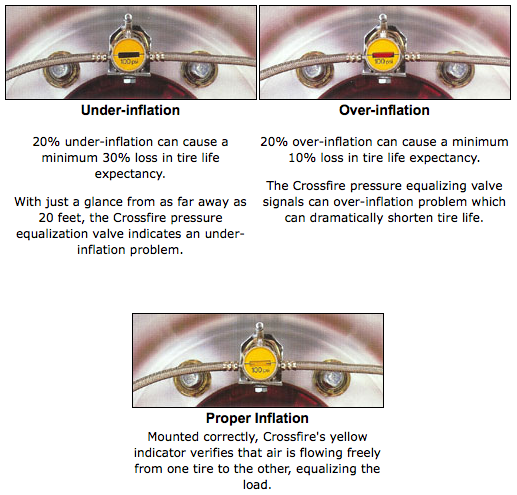Crossfire Dual Tire Pressure Equalization System
Tires
Dual tires have a set of problems all their own. In motion, the inner tire’s temperature increases due to in-board brakes and poor air circulation. This causes increased air pressure, which expands the inner tire’s diameter. As a result, the dual tire configuration is now distorted – the diameters are unequal.
The Crossfire Dual™ Tire Pressure Equalization System:
• maximizes tire life
• decreases rolling resistance for increased fuel mileage
• cuts maintenance time due to single-point inflation and the visual pressure gauge
• improves stability, braking, and overall safety
• installs in minutes and requires little maintenance
• pays for itself in less than a year
• American-made and guaranteed for two years
How Crossfire Works
Crossfire is a pressure-equalizing and monitoring valve that is mounted between dual tires. It bolts easily to the lug, hub cap, or drive axle end. Properly mounted, air freely flows from one tire to the other, maintaining equal tire pressure and load distribution. To fully appreciate how the Crossfire system can add 20% or more life to your tires, let’s look at a few problems.

The Road
The pavement itself causes problems that affect tire wear. Because highways are not perfectly flat, the pavement causes unequal tire loading. As these charts indicate, the Crossfire system drastically reduces problems created by the road.
Duals Without Crossfire
Duals With Crossfire
Install and Save
Every mile you roll with Crossfire saves you money. Big money. Install the leading dual tire pressure equalization system on the market, and begin saving 20% or more on tire wear.
Blowout and Leaks
Crossfire employs a safety feature that automatically isolates the “good” tire in the event of a blowout. When a blowout occurs, the internal safety valve closes immediately with only a slight loss of pressure to the “good” tire.
In slow leak situations, the valve isolates both tires after a pressure drop of approximately 10 P.S.I.